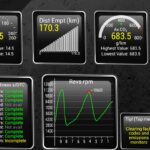Diagnosing engine performance issues can be complex, but modern OBD2 scanners offer valuable insights into your car’s health. One crucial parameter you might encounter is spark advance. While the original post discussed troubleshooting a rich fuel condition in a 2001 Acura EL (similar to a 2001-04 Civic Si engine), understanding Obd2 Spark Advance can be another key element in diagnosing engine problems, especially those related to fuel efficiency and performance.
The initial forum post highlighted high pre-cat O2 sensor readings (0.5-0.65V), suggesting a rich air-fuel mixture. The expert advice focused on potential causes like leaking fuel injectors, fuel pressure issues, a stuck fuel pump, or a faulty fuel pressure regulator. These are all valid points when addressing a rich condition indicated by OBD2 sensor data.
However, let’s broaden the scope slightly to understand how spark advance fits into the bigger picture of engine diagnostics and how OBD2 systems monitor it. Spark advance, or ignition timing advance, refers to how many degrees before top dead center (BTDC) the spark plug fires in each cylinder. Optimizing spark advance is critical for efficient combustion, power output, and fuel economy.
Why is OBD2 Spark Advance Important?
- Performance and Efficiency: The engine control unit (ECU) constantly adjusts spark advance based on various factors like engine load, speed, and temperature to achieve optimal combustion. Incorrect spark advance can lead to reduced power, poor fuel economy, and increased emissions.
- Detonation/Knocking: Too much spark advance can cause detonation or engine knocking, which is damaging to engine components. OBD2 systems monitor for knock and can retard timing to protect the engine.
- Diagnostic Clues: While not directly related to the rich fuel condition in the original post, abnormal spark advance readings on an OBD2 scanner can indicate underlying issues. These could range from sensor malfunctions (crankshaft position sensor, camshaft position sensor) to more serious mechanical problems.
Connecting Rich Fuel Mixture and Spark Advance (Indirectly)
In the context of the original post, the focus was rightly on the fuel system. A rich fuel mixture is primarily a fuel delivery problem. However, in a more general diagnostic approach, considering spark advance alongside fuel trims and O2 sensor readings provides a more holistic view.
While a rich condition isn’t caused by spark timing being off in most common scenarios, extremely retarded timing could, in theory, lead to incomplete combustion and potentially contribute to unburnt fuel in the exhaust, indirectly affecting O2 sensor readings over time. It’s less likely the primary cause of a rich condition, but it’s part of the overall engine management system that OBD2 diagnostics can help assess.
Troubleshooting Steps (Expanded from Original Post)
Building upon the original advice, here’s a more comprehensive troubleshooting approach when using OBD2 for engine diagnostics, considering spark advance and related issues:
- Initial OBD2 Scan: Use an OBD2 scanner to read diagnostic trouble codes (DTCs). Note down any codes related to the fuel system (e.g., rich mixture codes, O2 sensor codes), but also check for codes related to timing or misfires.
- Live Data Analysis: Examine live OBD2 data. Pay attention to:
- O2 Sensor Readings: As mentioned in the original post, high pre-cat O2 readings suggest a rich condition.
- Fuel Trims (Short Term and Long Term): Negative fuel trims also indicate the ECU is trying to lean out a rich mixture.
- Spark Advance: Monitor spark advance at idle and under load. Significantly retarded or excessively advanced timing could indicate a problem. Compare readings to expected values for your vehicle if possible.
- MAF/MAP Sensor Readings: Incorrect readings from the mass airflow (MAF) or manifold absolute pressure (MAP) sensors can also lead to incorrect fuel calculations.
- Fuel System Checks (as per original post):
- Fuel Injector Leak Test: Investigate potential leaking injectors.
- Fuel Pressure Test: Check fuel pressure and pressure drop to rule out fuel pressure regulator or pump issues.
- Sensor Checks:
- O2 Sensors: Verify O2 sensor functionality.
- Crankshaft/Camshaft Position Sensors: These sensors are crucial for timing. Faulty sensors can cause timing issues.
- Coolant Temperature Sensor: Incorrect coolant temperature readings can affect fuel mixture and timing.
- Exhaust Leak Inspection: Check for exhaust leaks before the O2 sensors, as these can introduce false lean readings, which the ECU might compensate for by enriching the mixture.
Conclusion
While the original forum post effectively addressed the rich fuel mixture issue, understanding OBD2 spark advance adds another dimension to engine diagnostics. OBD2 scanners are powerful tools for monitoring various engine parameters, including spark advance and fuel system data. By systematically analyzing this data and performing targeted troubleshooting steps, you can effectively diagnose and resolve a wide range of engine performance problems. Remember to consult your vehicle’s repair manual for specific values and procedures.
